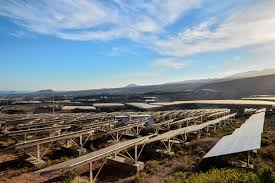At the Uganda Chamber of Energy and Minerals (UCEM) Budget Breakfast Meeting held on June 20 at Four Points by Sheraton, Deputy Executive Director of the National Planning Authority (NPA), Charles Oleny Ojok, laid out a bold government vision for Uganda’s energy and extractive sectors. His presentation revealed ambitious plans that aim to transform the country’s power generation, mineral development, and oil and gas industries.
Ojok announced that Uganda intends to boost its electricity generation capacity from the current 2,047 megawatts to a whopping 15,420 megawatts in the short to medium term. This growth will be achieved through a mix of energy sources including hydro, solar, geothermal, and nuclear power. Notably, the government has plans to build a nuclear power plant in Buyende, marking a significant step in diversifying the country’s energy mix.
The government’s agenda also focuses on rural electrification, targeting one million new electricity connections by the fiscal year 2025/26. Alongside this, there is a push to promote energy efficiency and transition towards greener, more sustainable energy options.
In the minerals sector, Ojok shared a broad strategy aimed at expanding geological mapping and adding value to key minerals such as iron ore, gold, phosphates, rare earth elements, limestone, and marble. This strategy seeks to increase Uganda’s competitiveness and attract more investors by improving infrastructure like roads, power transmission lines, and data systems.
In the oil and gas sector, progress is evident with the East African Crude Oil Pipeline (EACOP) currently 58% complete. Engineering work is almost finished at 98%, and procurement of major equipment stands at 83%. Meanwhile, Kabalega International Airport is nearing completion. This airport, together with expansions in oil storage and distribution networks, will support Uganda’s emerging commercial oil production.
Ojok also highlighted the crucial role of the private sector in Uganda’s energy growth. Independent Power Producers (IPPs) such as Xsabo, Access Solar, Bufulubi, Tororo, and Busitema are already helping to increase the country’s solar power capacity. The government remains open to more investments in wind, geothermal, and clean cooking technologies, promoting a diverse and sustainable energy future.
Electricity tariffs remain favourable to attract large consumers, set at 5 US cents per kilowatt-hour. Additionally, the Energy Rebate Scheme targets investors in remote areas, encouraging industrial development beyond urban centres.
In terms of immediate priorities, the government plans to carry out airborne geophysical surveys, establish three mineral buying centres, and launch pilot beneficiation projects to boost local processing of minerals. The long-term vision includes developing Uganda’s first petrochemical corridor and increasing in-country value retention in the extractives sector to 60% by 2030.
The meeting also saw UCEM CEO Humphrey Asiimwe call for concrete actions to support the sector’s growth. Asiimwe urged the fast-tracking of the Minerals and Mining Act (2022) and improving access to patient capital, which is essential for long-term investments. He stressed the need for a national energy-minerals knowledge hub to strengthen data governance and pushed for stronger enforcement of local content through skills training and contract inclusion.
Asiimwe highlighted the importance of operationalising major infrastructure projects such as the refinery, EACOP, and Kabalega Airport through transparent partnerships. He also flagged the urgent need for better roads to mineral sites like Blencowe Resources in Orom, Wagagai Gold Mine, and artisanal mining areas in Mubende and Buhweju. These roads are critical for logistics, safety, and boosting investor confidence.
On the budget front, Asiimwe welcomed the government’s allocation of Shs 875.8 billion for mineral-based industrial development in the FY2025/26 budget. Although this is slightly lower than the Shs 961 billion allocated in FY2024/25, the funds will support key projects like resource quantification, the Uganda National Mining Company, and refinery and pipeline developments. “Let’s build a future where Uganda’s natural wealth delivers profit, empowers people, and protects the planet,” he said.
Pamela Natamba, Partner at PwC, praised the relative stability of the Ugandan shilling, calling it a major boost for business planning. However, she raised concerns about the Shs 4 trillion budgeted for the four priority sectors under the Agro-Industrialisation, Tourism, Minerals, and Science (ATMs) framework. This amount represents just 5% of the total national budget of Shs 72.3 trillion. The funds are split as follows: 46% for agro-industrialisation, 22% for minerals (including oil and gas), 21% for science, technology, and innovation, and 11% for tourism.
Natamba urged urgent capacity building in the mining sector, especially to strengthen the National Mining Company. She also reviewed proposed FY2025/26 tax amendments, advocating for reforms that balance revenue generation with business competitiveness.
Hon. Richard Kaijuka, Chairman of UCEM’s Board of Trustees and former Minister of Energy and Mineral Development, spoke candidly about challenges in Uganda’s budget execution. He pointed out that while loans are often secured quickly, delays in disbursement mean taxpayers pay interest on unused funds. Drawing on his experience in public service and business, Kaijuka called for greater innovation and practical decision-making. “Stay away from politics if you can’t make a real difference. That’s my personal view,” he warned, urging stakeholders to focus on meaningful results.
The UCEM meeting brought together policymakers, private investors, and sector players, focusing on turning budget allocations into real actions for Uganda’s energy and mineral sectors. The shared vision is clear: boost production, attract investment, build infrastructure, and ensure Uganda’s natural resources benefit the people and economy for years to come.
